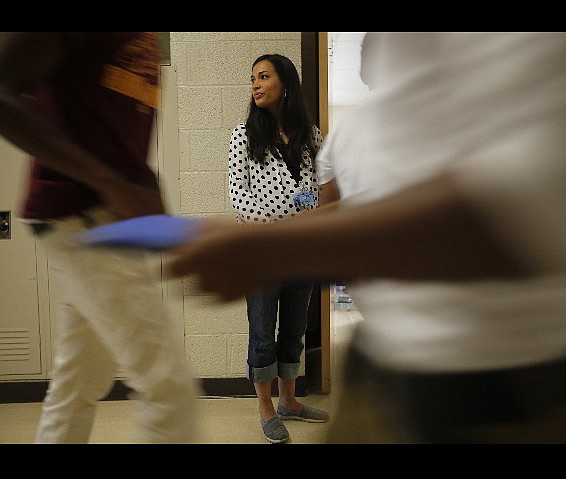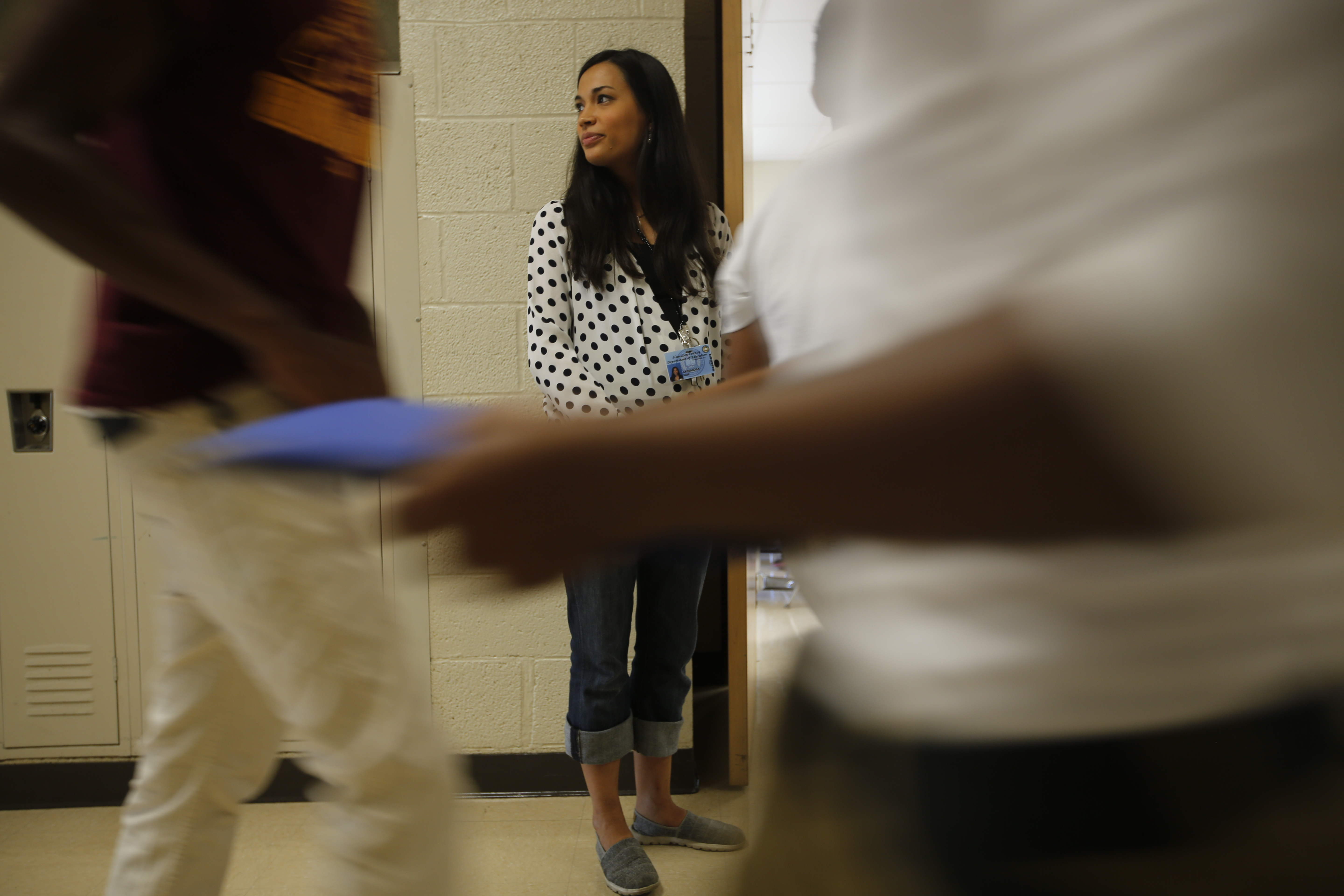The Howard School has long been a source of pride in Chattanooga's black community.
For years, it was the only high school where blacks were allowed to go. Class photos dating back to 1927 show only black faces -- including during the 1960s, '70s and '80s after segregation ended. A mural in the front lobby depicts Howard students engaged in civil rights-era sit-ins at segregated lunch counters downtown. A painted portrait hangs nearby of the school's most famous graduate, pro football Hall-of-Famer Reggie White.
But the face of Howard School is changing. An influx of English-language learners this fall has vaulted the percentage of Spanish speakers to about 25 percent of the student body. And that percentage is only expected to rise due to a Latino population in the area surrounding the school.
Chattanooga's Latino community tripled in size between 2000 and 2010, according to the U.S. Census Bureau. And since then, more have arrived.
"The Dodds Avenue-23rd Street area is quite different than it was three years ago," School Superintendent Rick Smith said at a recent school board meeting, referring to the influx of Latino residents.
Former school board member Jeffrey Wilson, whose last meeting was Thursday night, thinks there's no turning back.
"Howard, in X number of years, will probably be majority Latino," Wilson said.
That will mark a sea change not just for this predominantly black school, but for the black community whose heritage runs so deep here that they rallied to save Howard from the wrecking ball in 2002 when they could have had a new building.
"We really don't have a school, now, if this change occurs," said state Rep. Jo Ann Favors, who graduated from Howard in 1960.
She wishes Howard had been made into a magnet school, and that more money had been invested in it over the years.
"Howard is part of our legacy, and it would have been good to have guaranteed it as such," Favors said. "African-Americans, with the gentrification and other demographic changes, it seems that we're just left out. And, perhaps, that's our fault. Because we haven't been as rigorous making sure our history is sustained."
•••
Howard was Chattanooga's first public school.
It was established in 1865, following the end of the Civil War, and is named after Union Gen. Oliver O. Howard, an ardent abolitionist. This year the school will celebrate its 150th anniversary.
And over the decades Howard has produced a number of Chattanooga's black leaders.
Favors is among them.
Like others who have walked the halls, experienced the glory days and the school's sense of family, Favors has fond memories of the Howard she knew.
In those days, Howard was for first- through 12th-grade students."The older students looked out for the younger ones," Favors said. "The teachers were strict disciplinarians, but you felt a sense of home."
Favors said she can't go to the supermarket without being stopped by former classmates.
"I think that's been part of my success -- so many people know me," said Favors, who was elected in 1998 as a county commissioner and has served since 2004 in the Tennessee General Assembly.
She has seen black students -- including from her own family -- struggle after they left Howard to attend other area high schools.
"They don't adapt, because they were not in an environment that was conducive to your success," Favors said. "You do better with your own people when you're being educated."
Favors said she experienced hostility while getting a degree as a licensed practical nurse after she graduated from Howard.
"I was in one of the first nursing classes that was desegregated, and I caught hell," said Favors, who said she was falsely accused of such things as plagiarizing. "It took me 20 years to get over some of what was done to me."
Another high-profile grad has a different take on the demographic shift at Howard.
"I don't look at the race at Howard," said school board member George Ricks, who is black and whose District 4 includes Howard. "We're open to all races."
"We're just glad to see students," Ricks said. "If Howard stays alive, then the legacy of Howard stays alive."
•••
The shift in demographics is occurring all across schools in Hamilton County as well as the state and the nation. Hamilton County schools were about 65 percent white in 2000. Now the district is 58 percent white.
Today schools here have students who are from Bosnia, South Sudan and Vietnam. Yet much of the change is being driven by Latino students.
Howard had only a handful of Latinos until the English learners arrived this fall. New students continued to trickle in daily after school started, officials said last week.
"Chattanooga is getting a wave of immigration right now," said Nicholas Nagle, who co-authored a 2012 paper profiling Tennessee's Hispanic population for the University of Tennessee's Center for Business and Economic Research in Knoxville.
Chattanooga is between 5 and 6 percent Hispanic, he said, and their number should continue to grow -- as long as the economy is good.
"You're getting a lot of spillover migration from Atlanta," Nagle said. "Atlanta is a major new destination for Hispanic migrants."
About two-thirds of Chattanooga's Hispanics are from Mexico, he said, and one-third are from Latin America.
Nagle said Wilson could be right that Howard will turn primarily Latino -- though Nagle thinks it could take 10 or 20 years.
Wilson, who is black, bases his prediction of a Latino-dominated Howard on the demographics at primary schools that send students to Howard, including East Lake Elementary School. It's 40 percent black, 10 percent white and 50 percent "other," according to the school district's 10th-day enrollment figures.
"Eventually, those [Latino] kids will make their way into high school," he said.
Wilson attended Brainerd High School in the early '80s, around the turbulent time its student body changed from majority white to black -- and the school's mascot switched from rebels to panthers.
He said Howard is seeing a similar demographic shift. Not only are Latino students moving in, but black students are moving out of the district, for example when public housing is lost.
"A lot of it is the housing," Wilson said. "You look at the demolition of public housing. A lot of people are being relocated."
•••
Staff at Howard are upbeat about the new students.
"I feel like this is going really well," guidance counselor Ismahen Kadrie said.
Howard had an abrupt increase of about 130 Spanish-speaking ninth- and 10th-graders this school year, because the school is the new home to English for Speakers of Other Languages (ESOL) classes.
The students live near Howard and are zoned to go to school there, but they had been sent to English-language classes at East Ridge High School until its classes filled up.
"The numbers just increased to the point where East Ridge High School did not have the capacity," said Julie Legg, director of the Hamilton County Department of Education's ESOL programs. "We had to send the students who were zoned for Howard back to their zoned school."
"This is a change in the community," Legg said. "These kids, that's where they go. That's their school."
Howard and East Ridge also have an influx of teenage refugees from Latin America who crossed the border illegally without parents or guardians.
"A lot of them have refugee status," Howard ESOL teacher Iris Negrete-Regagnon said. "Almost all of them are from Guatemala. They've been through some horrible situations. The stuff you hear about on the news. It's all here."
They're staying with family members -- in some cases, with people whom they had never met, Negrete-Regagnon said.
"Not only are they coming where they don't know the language, they don't know anybody," she said.
"They all want to be doctors," Negrete-Regagnon said. "There's one guy who wants to be an engineer. They all have big dreams."
Howard Principal Zac Brown said Howard's African-American students aren't making a big deal about the Latino newcomers, because they already know each other from the neighborhood.
"They live together," Brown said. "They're in the same neighborhood."
"We've yet to have any issues," he said. "From 9 to 4, we're all Tigers."
He's not sure that Howard will become majority Latino. Brown predicts that in the next couple of years Howard will become 60 percent African-American and 40 percent Latino.
"I think it's just the trend we have in the Chattanooga area," he said. "It's better for kids to go to their zoned school."
One thing is going to change at Howard, because of the new students.
"This year, I'm confident that we will have a boys soccer team in the spring," Brown said.
Contact staff writer Tim Omarzu at tomarzu@timesfreepress.com or twitter.com/TimOmarzu or 423-757-6651.

